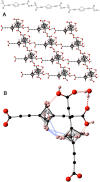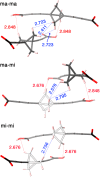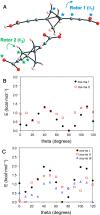Asymmetric Choreography in Pairs of Orthogonal Rotors
- PMID: 29399655
- PMCID: PMC5793037
- DOI: 10.1021/acsomega.7b01580
Asymmetric Choreography in Pairs of Orthogonal Rotors
Abstract
An asymmetric mechanism for correlated motion occurring in noninteracting pairs of adjacent orthogonal 1,4-bis(carboxyethynyl)bicyclo[1.1.1]pentane (BCP) rotators 1 in the solid state is unraveled and shown to play an important role in understanding the dynamics in the crystalline rotor, Bu4N+[1-]·H2O. Single crystal X-ray diffraction and calculation of rotor-rotor interaction energies combined with variable-temperature, variable-field 1H spin-lattice relaxation experiments led to the identification and microscopic rationalization of two distinct relaxation processes.
Conflict of interest statement
The authors declare no competing financial interest.
Figures





Similar articles
-
Crystalline arrays of pairs of molecular rotors: correlated motion, rotational barriers, and space-inversion symmetry breaking due to conformational mutations.J Am Chem Soc. 2013 Jun 26;135(25):9366-76. doi: 10.1021/ja4044517. Epub 2013 Jun 14. J Am Chem Soc. 2013. PMID: 23725407
-
Design and evaluation of a crystalline hybrid of molecular conductors and molecular rotors.J Am Chem Soc. 2012 May 9;134(18):7880-91. doi: 10.1021/ja301484b. Epub 2012 Apr 25. J Am Chem Soc. 2012. PMID: 22500581
-
Nanoscale rotational dynamics of four independent rotators confined in crowded crystalline layers.Nanoscale. 2020 Apr 21;12(15):8294-8302. doi: 10.1039/d0nr00858c. Epub 2020 Apr 1. Nanoscale. 2020. PMID: 32236227
-
Ultra-fast rotors for molecular machines and functional materials via halogen bonding: crystals of 1,4-bis(iodoethynyl)bicyclo[2.2.2]octane with distinct gigahertz rotation at two sites.J Am Chem Soc. 2011 Apr 27;133(16):6371-9. doi: 10.1021/ja200503j. Epub 2011 Apr 6. J Am Chem Soc. 2011. PMID: 21469644
-
Quantum-rotor-induced polarization.Magn Reson Chem. 2018 Jul;56(7):610-618. doi: 10.1002/mrc.4725. Epub 2018 Apr 15. Magn Reson Chem. 2018. PMID: 29460384 Review.
Cited by
-
Bridging and Conformational Control of Porphyrin Units through Non-Traditional Rigid Scaffolds.Chemistry. 2020 Feb 21;26(11):2405-2416. doi: 10.1002/chem.201904199. Epub 2020 Jan 21. Chemistry. 2020. PMID: 31697426 Free PMC article.
-
Chlorinated Cubane-1,4-dicarboxylic Acids.J Org Chem. 2024 Aug 16;89(16):11100-11108. doi: 10.1021/acs.joc.2c02872. Epub 2023 Feb 1. J Org Chem. 2024. PMID: 36724049 Free PMC article.
-
Origin of the isotropic motion in crystalline molecular rotors with carbazole stators.Chem Sci. 2019 Mar 20;10(16):4422-4429. doi: 10.1039/c8sc04398a. eCollection 2019 Apr 28. Chem Sci. 2019. PMID: 31057769 Free PMC article.
-
Cascade Dynamics of Multiple Molecular Rotors in a MOF: Benchmark Mobility at a Few Kelvins and Dynamics Control by CO2.J Am Chem Soc. 2021 Aug 25;143(33):13082-13090. doi: 10.1021/jacs.1c03801. Epub 2021 Aug 13. J Am Chem Soc. 2021. PMID: 34388339 Free PMC article.
-
An Insight into Non-Covalent Interactions on the Bicyclo[1.1.1]pentane Scaffold.European J Org Chem. 2021 Feb 19;2021(7):1113-1122. doi: 10.1002/ejoc.202001564. Epub 2020 Dec 22. European J Org Chem. 2021. PMID: 33776556 Free PMC article.
References
-
- Lemouchi C.; Mézière C.; Zorina L.; Simonov S.; Rodríguez-Fortea A.; Canadell E.; Wzietek P.; Auban-Senzier P.; Pasquier C.; Giamarchi T.; Garcia-Garibay M. A.; Batail P. Design and evaluation of a crystalline hybrid of molecular conductors and molecular rotors. J. Am. Chem. Soc. 2012, 134, 7880–7891. 10.1021/ja301484b. - DOI - PubMed
-
- Kaleta J.; Nečas M.; Mazal C. 1,3-Diethynylbicyclo[1.1.1]pentane, a useful molecular building block. Eur. J. Org. Chem. 2012, 4783–4796. 10.1002/ejoc.201200351. - DOI
- Kaleta J.; Michl J.; Mazal C. T-shaped molecular building blocks by combined bridgehead and bridge substitution on bicyclo[1.1.1]pentanes. J. Org. Chem. 2010, 75, 2350–2356. 10.1021/jo100169b. - DOI - PubMed
- Kaleta J.; Janoušek Z.; Nečas M.; Mazal C. Molecular rods combining o-carborane and bicyclo[1.1.1]pentane cages: an insertion of the triple bond located next to a highly strained cage. Organometallics 2015, 34, 967–972. 10.1021/acs.organomet.5b00002. - DOI
- Cipolloni M.; Kaleta J.; Mašát M.; Dron P. I.; Shen Y.; Zhao K.; Rogers C. T.; Shoemaker R. K.; Michl J. Time-resolved fluorescence anisotropy of bicyclo[1.1.1]pentane/tolane-based molecular rods included in tris(o-phenylenedioxy)cyclotriphosphazene (TPP). J. Phys. Chem. C 2015, 119, 8805–8820. 10.1021/acs.jpcc.5b01960. - DOI - PMC - PubMed
-
- Iwamura H.; Mislow K. Stereochemical consequences of dynamic gearing. Acc. Chem. Res. 1988, 21, 175–182. 10.1021/ar00148a007. - DOI
- Nakamura M.; Kishimoto K.; Kobori Y.; Abe T.; Yoza K.; Kobayashi K. Self-assembled molecular gear: a 4:1 complex of Rh(III)Cl tetraarylporphyrin and tetra(p-pyridyl)cavitand. J. Am. Chem. Soc. 2016, 138, 12564–12577. 10.1021/jacs.6b07284. - DOI - PubMed
- Jiang X.; O’Brien Z. J.; Yang S.; Lai L. H.; Buenaflor J.; Tan C.; Khan S.; Houk K. N.; Garcia-Garibay M. A. Crystal fluidity reflected by fast rotational motion at the core, branches, and Peripheral aromatic groups of a dendrimeric molecular rotor. J. Am. Chem. Soc. 2016, 138, 4650–4656. 10.1021/jacs.6b01398. - DOI - PMC - PubMed
- Sanada K.; Ube H.; Shionoya M. Rotational control of a dirhodium-centered supramolecular four-gear system by ligand exchange. J. Am. Chem. Soc. 2016, 138, 2945–2948. 10.1021/jacs.5b13515. - DOI - PubMed
- Frantz D. K.; Linden A.; Baldridge K. K.; Siegel J. S. Molecular spur gears comprising triptycene rotators and bibenzimidazole-based stators. J. Am. Chem. Soc. 2012, 134, 1528–1535. 10.1021/ja2063346. - DOI - PubMed
-
- Lemouchi C.; Iliopoulos K.; Zorina L.; Simonov S.; Wzietek P.; Cauchy T.; Rodríguez-Fortea A.; Canadell E.; Kaleta J.; Michl J.; Gindre D.; Chrysos M.; Batail P. Crystalline Arrays of Pairs of Molecular Rotors: Correlated Motion, Rotational Barriers, and Space Inversion-symmetry Breaking due to Conformational Mutations. J. Am. Chem. Soc. 2013, 135, 9366–9376. 10.1021/ja4044517. - DOI - PubMed
- Bastien G.; Lemouchi C.; Allain M.; Wzietek P.; Rodríguez-Fortea A.; Canadell E.; Iliopoulos K.; Gindre D.; Chrysos M.; Batail P. Changing gears to neutral in a polymorph of one-dimensional arrays of cogwheel-like pairs of molecular rotor. CrystEngComm 2014, 16, 1241–1244. 10.1039/c3ce42054j. - DOI
-
- Kaleta J.; Michl J.; Mézière C.; Simonov S.; Zorina L.; Wzietek P.; Rodríguez-Fortea A.; Canadell E.; Batail P. Gearing motion in cogwheels pairs of molecular rotors: weak-coupling limit. CrystEngComm 2015, 17, 7829–7834. 10.1039/c5ce01372k. - DOI
LinkOut - more resources
Full Text Sources
Other Literature Sources
Miscellaneous

